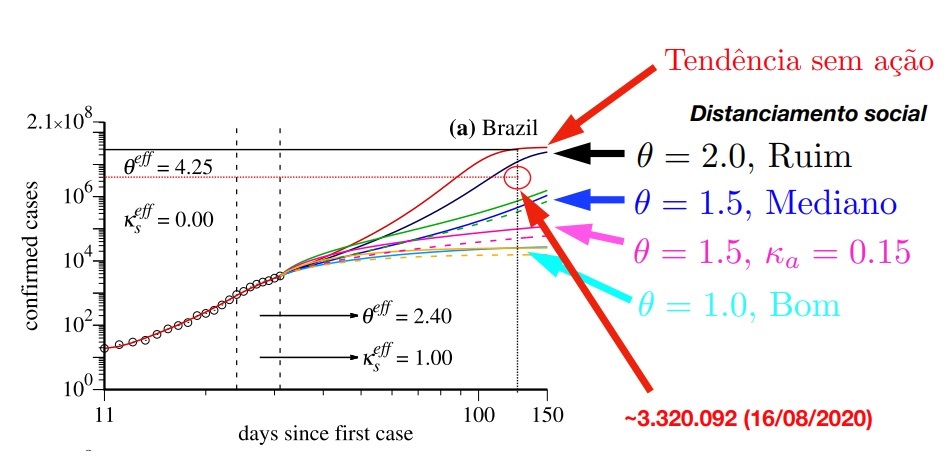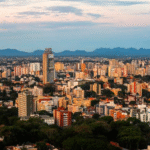Scientists have also evaluated cases of infected individuals and emphasize the importance of a high level of social distancing, that is a universal strategy for flattening the curve #AgenciaEscolaUFPR
By Breno Antunes da Luz
Under the supervision of Chirlei Kohls
Translation by CAPA
‘Surely, the number of infected people would be much lower if more severe strategies of social distancing had been adopted’, points out Marcus Beims, researcher and professor at the Physics Department of UFPR, Brazil. Beims analyzed the effectiveness of strategies to face the pandemic around the world, along with four other Brazilian scientists from Federal University of Paraná (UFPR), State University of Santa Catarina (Udesc) and State University of Amazonas (UEA). The researchers evaluated nine countries on three continents to understand how the fight against COVID-19 could be more effective. The results reinforce that the best methods to combat it are mass testing and social isolation, at least while vaccination is not possible.
The data were published in twointernational scientific journals, the latest being in the August edition of the British journal Chaos,Solitons and Fractals. For the analysis, the authors revisited the first results published in the journal Chaos about the growth in the number of confirmed cases by the end of March in Germany, Brazil, China, South Korea, Spain, United States, France, Italy, and Japan.

Both publications show that strategies for flattening the curve tend to be the same, regardless of country or continent. “Our goal is to understand the way this virus spreads and to propose practical strategies to contain its growth: high rate of social distancing, along with a high number of daily tests, and isolation of infected people,” says professor Marcus.
According to Eduardo Brugnago, a PhD student at UFPR and one of the researchers, the study adds to several others, to show that the rigorous implementation of social distancing leads to a reduction in the number of new cases. “Individual protection measures reduce the probability of contamination. Other factors, such as isolation of infected individuals, which requires infrastructure and some logistics for mass testing and the secure allocation of these people to be possible, are allies in dealing with the pandemic but are not easy to apply in Brazil [because of its large population, for example]. Hence the importance of maintaining social distancing.”
Alongside professor Marcus and PhD student Eduardo, professor Rafael da Silva, also from UFPR’s Physics department, participated in the research. From other institutions, professors César Mancheim, from Udesc’s Physics department, and Carlos Mendes, from the State University of Amazonas, completed the group.
Mathematical model
adjusted to actual data
The study was divided into two stages. The first one deals with the real data, how the number of cases evolved, and how the curves present similar behavior for different countries. In the second one, the researchers employed a mathematical model with parameters adjusted to the real data, which allows them to draw hypothetical future scenarios.
The actual data were used in the model called Power Law, instead of the Exponential Law model, commonly used in this type of research. In the Exponential Law the number of new cases doubles at each time interval. In the Power Law, the growth is lower and suggests that the models used to describe this growth are different.
“The question is not so much about the number of infected individuals, but how growth occurs. This model [Power Law] includes the possibility of people eventually infecting someone from a distant location through a trip, for example,” Marcus explains.

The analysis involves the effectiveness of virus transmission and social interactions. It is similar to the what is known as the R(t) parameter, which refers to the mean number of people infected by one individual during the period of infection. When Rt is less than 1, the spread of the virus is under control; when Rt is greater than 1, the virus continues to spread.
The researchers used the parameter k_a (kappa) to simulate the tests of asymptomatic infected people. In Brazil, a k_a = 0.15 would cause the number of cases to decrease substantially. Nonetheless, it would still not be enough to completely control the spread of the coronavirus. This implies testing and isolating 15% of the asymptomatic infected individuals daily. “In a populous country like Brazil, this is nearly impossible, because to find so many asymptomatic cases in this huge country we need to test a lot more people,” says Marcus.
How could contamination
have been reduced?
According to Professor Marcus, simulations show that, if we had managed to keep Rt close to 1 since March 28, the number of infected individuals in Brazil could have been reduced by millions. “The resumption of activities at this time is terrible because it increases the Rt, which makes it possible for coronavirus to spread more easily. Even in cities where the number of infected people is decreasing, the increase in Rt favors the infection of new individuals”.
“The most relevant factor to contain the pandemic continues to be social distancing, that is, keeping the value of theta (or Rt) as low as possible,” reinforces Marcus.
New studies
The group is already working on other researches, especially to follow the aforementioned project. One of those is about the evolution of COVID-19 cases in Brazilian states. Another study, in partnership with State University of Ponta Grossa (UEPG), aims to understand the spread of the virus in Paraná, Brazil. In possession of this data, the researchers will analyze which cities are more susceptible to infection with the virus. Besides, the group is doing research in the effects of meteorological data on the number of new cases of the coronavirus.











